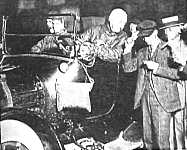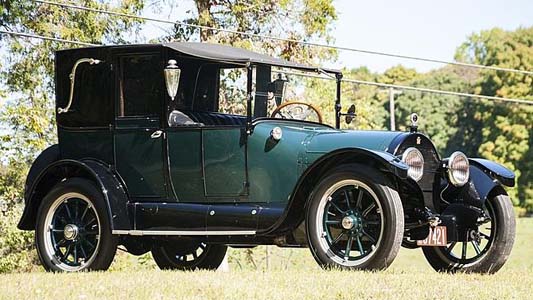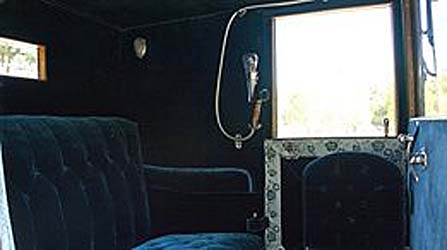The prestige of a motor car no longer depends upon a mere name, surrounded by a fictitious atmosphere of aristocracy ... it is the character of the car which sheds luster on the Cadillac name - not the name which confers luster on the car ... neither a man, nor a motor car, can live on a name alone ...
Such was the thinking behind the Cadillac company's advertising campaign in 1916. Deeds are demanded of mere mortal men. Performance was demanded of a motor car. To put Cadillac performance into perspective it should be recalled that in May 1916 a Mr. E.G. Baker drove a stock Cadillac roadster from Los Angeles to New York in 7½ days. Departing from LA at noon on Monday 8 May, he reached NY just before 3 p.m. the following Monday, breaking an earlier record by no less than four days. Baker is reported as saying: "Our best day's run was 567 miles. We would have averaged over 500 miles a day if it had not been for the bad roads we struck in Missouri; it took us 18 hours to drive about 300 miles, and it was rain and mud all the way". About the car's reliability, he added: "The engine never missed a shot, not even a spark plug needed cleaning. We never lifted the hood, except for oil, and once to adjust the carburetor".
|
|
Try to imagine the road system in America back in 1916. This was not the Eisenhower super-highway system we have known since the fifties. In 1916, many roads were impassable by automobile at their best, yet this sturdy little car completed the trip 3,372-mile trip in record time and despite adverse weather.
Into its second year with the new V8 engine, the 1916 models, the Type 53, were presented to potential buyers in a buff-colored , 36-page catalog measuring approx. 6 x 9 inches. Embossed in an oval medallion on the front cover were the words "Cadillac - Standard of the World"; below that was the Cadillac coat of arms encircled by a wreath of tulip bulbs (replaced in the sixties by Cycus leaves).
Compared to earlier models, the cars of 1916 are recognizable by A very rounded radiator shroud and grille, as well as a soft-shouldered engine hood with raised beading on the top surface. The base of the doors had an even curve on either side, whereas the 1915 models had a more square corner at the front. The 5-passenger salon model now had a driver's door. The new, 3-passenger Victoria had enclosed rear quarters. The 5-passenger sedan became the Brougham; it got four doors and lost the hump over the trunk area. The 7-passenger limousine lost its coach lamps. An enclosed berline-limousine was added; it featured narrow window glass between the front and rear door glass.
Another way to ID the 1916 cars is by the radiator emblem. White swans replaced the traditional black merlettes on the Cadillac crest on all models from 1916 through 1919; this was the company's way of showing its gratitude to Mr. Albert C. Swan, of Smith & Swan, a company that had given Cadillac precious help after the disastrous plant fire of April 1904 had halted Cadillac production for some three months. The firm reverted to the traditional black merlettes in 1920.
The 1916 models were classified into open and closed cars. There were three of the first category and four of the second. That is the order I have chosen to follow in this photo presentation. In the open category were (1) the standard seven-passenger car, a large open tourer, (2) the five-passenger salon, a shorter version of the previous car, with no auxiliary seating and (3) the two-passenger roadster. Closed cars included (1) the three-passenger Victoria, featuring enclosed rear quarters and dummy landau bars, (2) the five-passenger Brougham (a body style that went out of fashion in the late twenties and returned with a bang - with the bespoke Eldorado Brougham - some thirty years later, (3) the seven-passenger limousine with a semi-open driver's compartment (no side glass) and (4) a seven-passenger so-called "Berlin", from the French "berline" meaning sedan, that is an enclosed car with four doors.
No publication date is shown on that year's sales catalog, put out by Cargill-Peninsular Company of Detroit, MI.
|
|
Additional information on the 1916 models and the related sales literature may be found in The (New) Cadillac Database© sections entitled "Descriptions and Specifications of Cadillac Cars 1913-1921", "Cadillac and La Salle Sales Literature 1915-1919" and "Dream Cars 1903-1924".
Further recommended reading includes:
The "Standard Catalog of Cadillac, 1903-2000" edited by James T. Lenzke, © 2000, published by Krause Publications, Inc., 700 E. State Street, Iola, WI 54990 [ISBN #0-87341-925-1, Library of Congress #91-61301].
Space-permitting, some photos of surviving cars may be added here, later.



